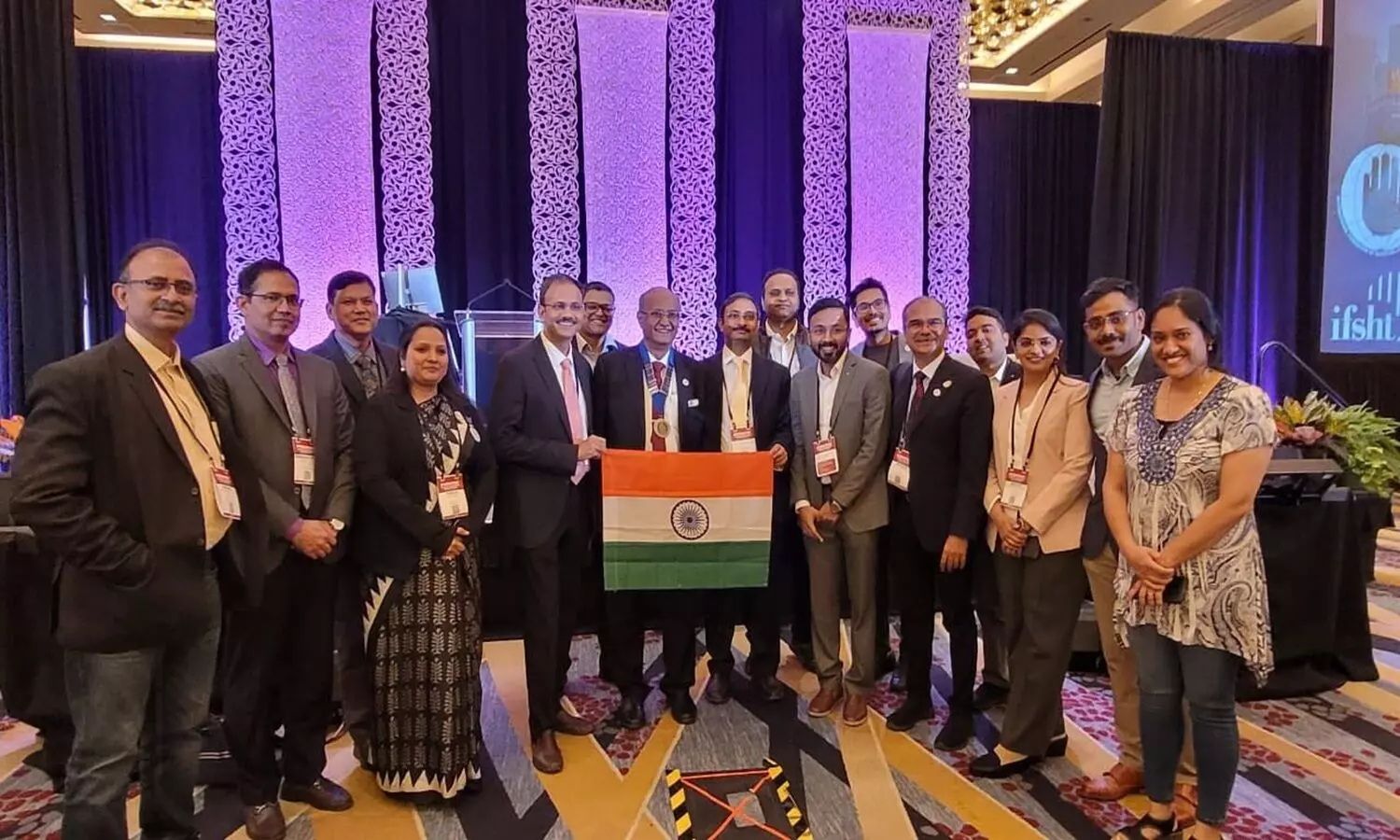Medical News, Health News Latest, Medical News Today - Medical Dialogues |
Serum MCP-1 and Osteopontin May Predict Early Renal Injury in Gout: Study
7 months 4 days ago
Nephrology,Nephrology News,Top Medical News
Build Your "Brain Bank" Now To Prevent Cognitive Decline In Your 70 Or 80s - MindBodyGreen
- Build Your "Brain Bank" Now To Prevent Cognitive Decline In Your 70 Or 80s MindBodyGreen
- Will Stimulating My Brain as I Age Keep It Sharp? The New York Times
- Does Wordle help? South Florida experts reveal ways keep your brain sharp Sun Sentinel
- Expert tips on how to keep memory razor sharp Times of India
- I've been studying the brain for 20 years. People who stay sharp throughout life do these 5 things CNBC
7 months 4 days ago
Three of the most obese cities in the US are in Alabama - AL.com
- Three of the most obese cities in the US are in Alabama AL.com
- This South Texas city has worst weight-related problems in U.S., study says San Antonio Express-News
- 2 Michigan Cities Among the Most Obese in U.S. 97.9 WGRD
- Augusta ranked one of the ‘most obese cities’ by WalletHub AJC.com
- Missouri City Lands on Most Obese City List for 2025 97.9 KICK FM
7 months 4 days ago
HHS starts layoffs of thousands of workers across its agencies
7 months 4 days ago
Breaking News, Politics, CDC, FDA, HHS, Public Health, RFK Jr.
2 SC cities face rising STD rates, among highest in US for 2025, study shows. See the full list - The State
- 2 SC cities face rising STD rates, among highest in US for 2025, study shows. See the full list The State
- New study says Lexington has among the highest STI rates in the country WKYT
- Ohio, Kentucky cities named in Top 25 U.S. cities with highest STI rates WKRC
- 2 Kentucky cities among US metros with highest STD rates, study says. See full list Lexington Herald Leader
- 8 Texas cities have among the highest STD rates in the country, study says. See the full list Fort Worth Star-Telegram
7 months 4 days ago
How to keep your memory sharp as you age - The Washington Post
- How to keep your memory sharp as you age The Washington Post
- Will Stimulating My Brain as I Age Keep It Sharp? The New York Times
- I've been studying the brain for 20 years. People who stay sharp throughout life do these 5 things CNBC
- Does Wordle help? South Florida experts reveal ways keep your brain sharp Sun Sentinel
- Landmark clinical trial shows how to maintain the brain as we age NZ Herald
7 months 4 days ago
Intermittent fasting can be hit or miss, but research suggests 'sweet spot' can help some stick to their diet - ABC News
- Intermittent fasting can be hit or miss, but research suggests 'sweet spot' can help some stick to their diet ABC News
- The Effect of 4:3 Intermittent Fasting on Weight Loss at 12 Months: ACP Journals
- Is intermittent fasting or calorie restriction better for weight loss? Here's what a new study found. CBS News
- This three-day-a-week diet leads to more weight loss than daily calorie counting: study New York Post
- Intermittent Fasting 3 Days a Week Tops Calorie Restriction for Weight Loss MedPage Today
7 months 4 days ago
Intermittent fasting beats daily calorie cutting for weight loss, scientists say - Financial Times
- Intermittent fasting beats daily calorie cutting for weight loss, scientists say Financial Times
- Intermittent fasting can be hit or miss, but research suggests 'sweet spot' can help some stick to their diet ABC News
- Fast, Don’t Count: How the 4:3 Fasting Rhythm Beat Daily Dieting in a Yearlong Study SciTechDaily
- This 3-day-a-week diet could be a vital weight loss strategy, say scientists BBC Science Focus Magazine
- How many days you need to fast to lose more weight than dieting The Telegraph
7 months 4 days ago
The Most Obese City in Missouri is…….. - 97.9 KICK FM
- The Most Obese City in Missouri is…….. 97.9 KICK FM
- Three of the most obese cities in the US are in Alabama AL.com
- This South Texas city has worst weight-related problems in U.S., study says San Antonio Express-News
- Augusta ranked one of the ‘most obese cities’ by WalletHub AJC.com
- Inside 'fattest city in US' where nearly half of the population is obese Daily Star
7 months 5 days ago
Health Archives - Barbados Today
A stroke survivor speaks again with the help of an experimental brain-computer implant
7 months 5 days ago
Health, United States, World
Bauta Rojas accuses Agriculture Minister of irresponsibility over swine flu
7 months 5 days ago
Health
Medical News, Health News Latest, Medical News Today - Medical Dialogues |
Novartis appoints Karen Hale as Chief Legal and Compliance Officer
7 months 5 days ago
News,Industry,Pharma News,Latest Industry News
Medical News, Health News Latest, Medical News Today - Medical Dialogues |
Dr S Raja Sabapathy takes over Presidency of International Federation of Societies for Surgery of the Hand
7 months 5 days ago
State News,News,Health news,Tamil Nadu,Doctor News,Latest Health News,Recent Health News
How Cold Water Rewires Your Cells to Fight Stress and Aging - SciTechDaily
- How Cold Water Rewires Your Cells to Fight Stress and Aging SciTechDaily
- Cold plunges improve your health by literally changing your cells Earth.com
- Ice Baths; What are the benefits? RI Body Restoration explains WPRI.com
- The Cellular Effects of Cold Plunging Revealed Technology Networks
- 3 Ways Cold Exposure Can Boost Your Muscle Growth and Recovery BOXROX
7 months 5 days ago
Medication taken by 1 in 8 Americans linked to substantial increase in the risk of sudden cardiac death - Fortune
- Medication taken by 1 in 8 Americans linked to substantial increase in the risk of sudden cardiac death Fortune
- Use of antidepressant medication linked to substantial increase in risk of sudden cardiac death Medical Xpress
- Long-term antidepressant use linked to higher cardiac death risk | Tap to know more | Inshorts Inshorts
- Health headlines: Anti-depressants and cardiac arrest news8000.com
- Antidepressant use linked to higher sudden cardiac death risk across age groups McKnight's Long-Term Care News
7 months 6 days ago
Schizophrenic hoping for better days - Jamaica Gleaner
Schizophrenic hoping for better days
Jamaica Gleaner
7 months 6 days ago
Health – Demerara Waves Online News- Guyana
Fireman’s death not due to GPHC’s deliberate negligence, gaps to be tightened
7 months 1 week ago
Accountability, Health, News, clinical coordination, fireman's death, Georgetown Public Hospital Corporation (GPHC), independent investigative panel, integrated approach, Mae's School fire, multidisciplinary communication, multifactorial medical conditions, reinforced escalation protocols, trauma management protocols
Parental modelling: A key strategy to tackle childhood obesity
7 months 1 week ago
Health, PRESS RELEASE, Youth, childhood obesity, gfnc, grenada food and nutrition council, health education




